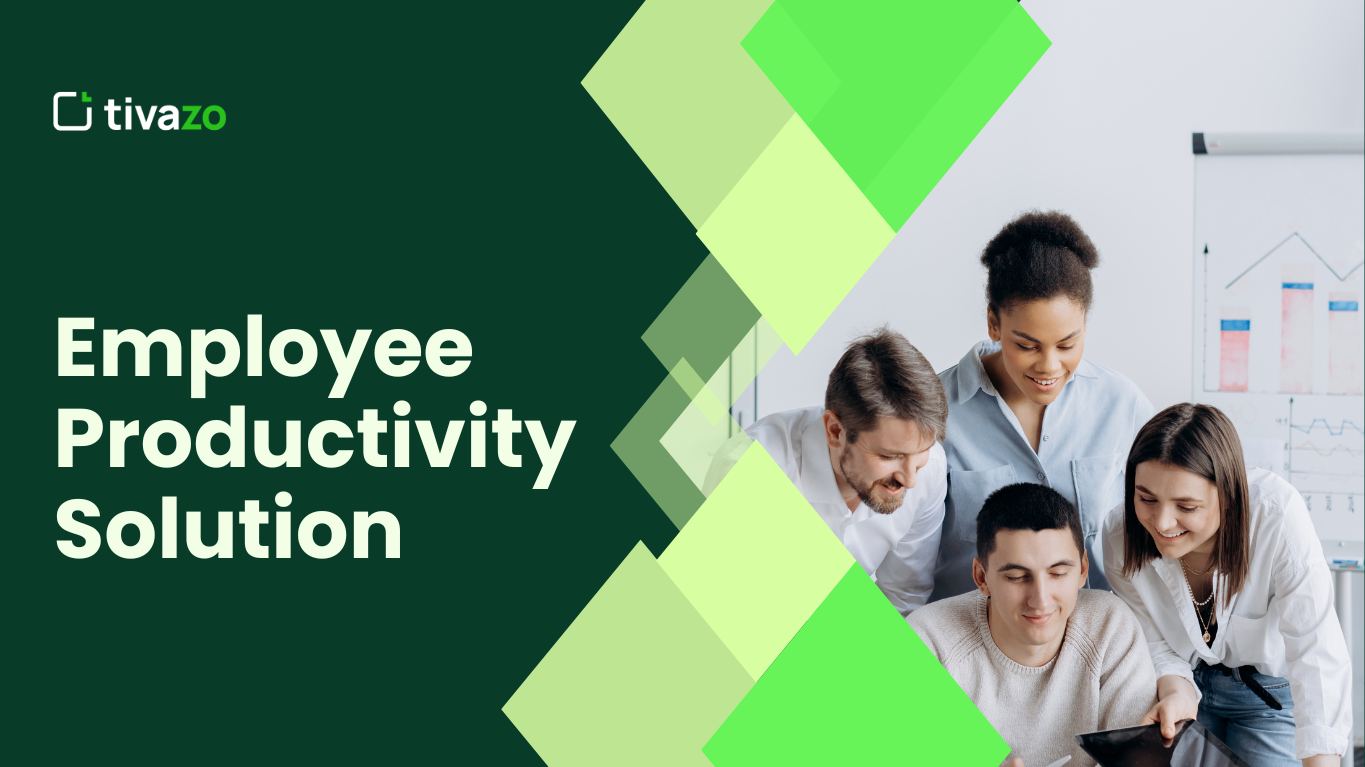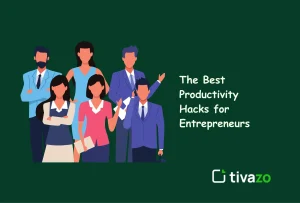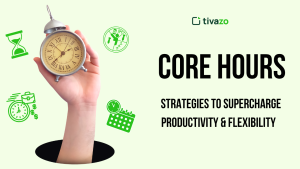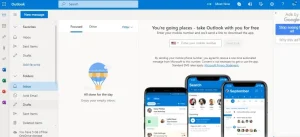In the current digital world, which is quite hectic, companies are under more pressure to be competitive and effective. Performance of the workforce is one of the main determinants of success. Employee Productivity solution is an option that continues to come up in the bids by organizations to improve organizational output and operational efficiency. This guide is all you need to know about employing the right employee productivity solution in your business.
What is an Employee Productivity Solution?
An employee productivity solution is a software, tool, or platform to control, evaluate, and enhance employee productivity and employee work efficiency. The solutions provide knowledge in areas of employee time utilization, productivity choke points, and improvement suggestions. An employee productivity solution with a correct implementation can infuse a lift in morale, improve process flow, and business performance measurement at a substantial level.
Why Businesses Need an Employee Productivity Solution
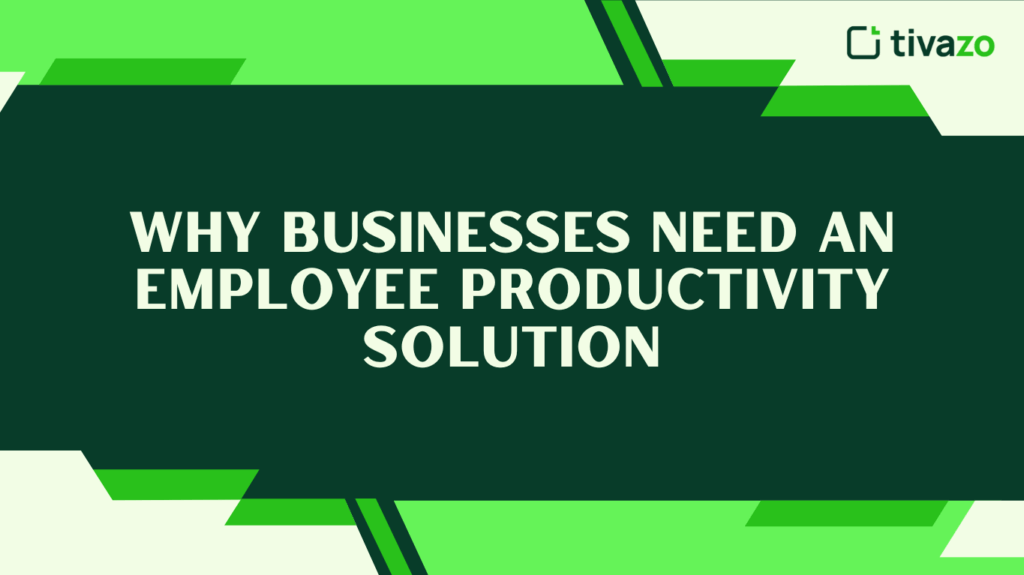
Enhanced Efficiency
Through real-time tracking and performance analytics, companies will find it easy to optimize operations and eliminate time-consuming processes. By determining how time is passed and what tasks require the most resources, organizations can make changes in the workflow and remove redundant stages, thus being able to complete tasks faster and allocate resources better.
Data-Driven Decisions
The corporate managers learn a lot, and hence the ability to make strategic decisions. These are obtained through detailed reports and performance analytics to identify patterns, the skillset of employees, and how the work is divided to help the leadership hone its approaches and distribute the work in a more efficient way.
Management Of Remote Workforce
The efficiency of remote or hybrid teams can only be achieved with the help of an employee productivity solution. It can give you an insight into daily operations, track productivity without being intrusive, and allow clear communication. This makes the remote workers responsible and connected, despite their location.
Employee Engagement
Correct usage of these tools may provide strengths and opportunities for improvements, which means that employees will be satisfied with the company. Organisations can ensure that employees grow in a specific topic, and also give recognition through the provision of metrics of performance and avenues through which responses can be given, leading to the development of a new culture of constant improvement.
Cost Savings
Increased productivity means the good utilization of resources and lower operational expenses. Businesses will be able to minimize headcount, overtime, and errors to the minimum, streamline the efficiency of their operations, and improve their productivity under the same budget.
Features to Look for in an Employee Productivity Solution
The following features are some of the bases one should use when selecting an appropriate employee productivity solution:
- Time Tracking: You will be able to see your time spent on a new level of detail with regard to tasks, projects, and applications. This aids workers and managers to locate time wasters, streamline the working timetables, and also be accountable in the team.
- Activity Monitoring: Monitors the activities of applications used, websites visited by the employees, to make sure that they remain focused on their jobs when at work. It gives an insight on the way work time is getting utilized, and it also allows identifying distractions or other browsing activities that can affect productivity.
- Reporting & Analytics: Provides personalized summary reports and dashboards with practical information on how a specific team is performing, attendance patterns, project timelines, and output of a particular individual. The result of these analytics is smarter decision-making and continuous process improvement.
- Project Management Integration: Easy integration with tools, such as Trello, Asana, Slack, Jira, Microsoft Teams and have a coherent platform to plan tasks and work with them, communicate. This is possible to provide improved collaboration, transparency, and tracking of the progress within current workflows.
- Goal Setting and Sequence Recording: It allows organizations to set out or mark out certain goals aiming at the formation of teams and individuals, which are certain and measurable in line with the organizational goals. It is possible to track the progress over time to assist the managers in taking employees to the milestones and achieving better results.
- User Privacy Options: Allows flexibility in their control so that monitoring is not in a way that infringes on the privacy of the workers. This could involve disallowing access to sensitive information, anonymity of reports, or tracking only when at work. Finding the right compromise between trust and transparency is essential to smooth adoption.
- Mobile Access: Allows monitoring the productivity of smartphones, tablets, and laptops, and is ideal in cases such as to remote employees and on the move employees. Portability makes it possible to keep working and it is visibly done in any location.
Types of Employee Productivity Solutions
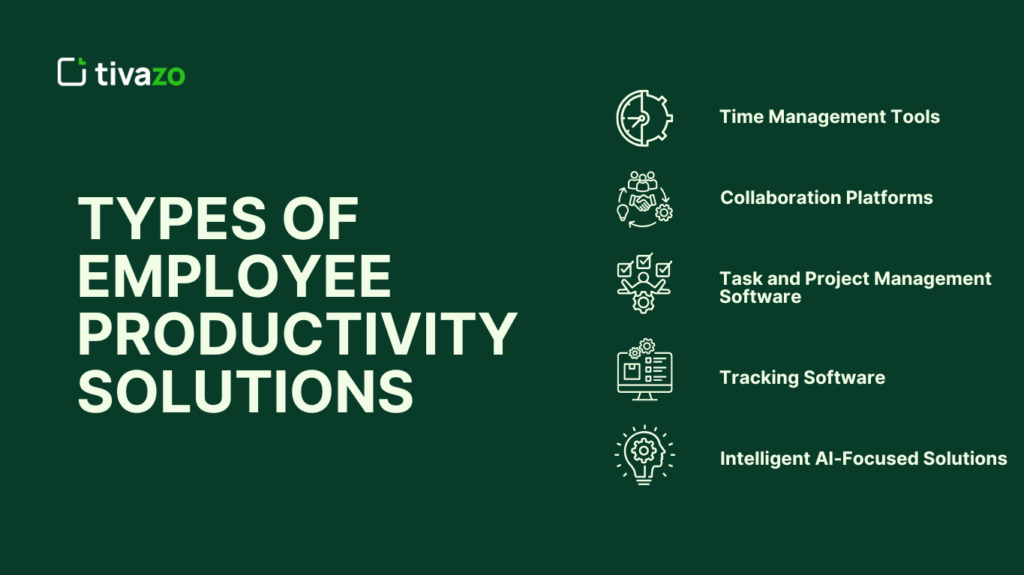
Time Management Tools: It can be used to keep a record of time expended on a particular task or project, or even a client. They help employees realize how they work, and pointless work rituals like giving too much time to work that does not deserve it, or procrastination. This information can help businesses to plan schedules and minimize time wastage, and maximize production.
Collaboration Platforms: This kind of platform is meant to boost the interaction with a team, when the employees are both in the office and out of it. They facilitate grouping documents, instant communication, online meetings, and working on projects, which helps enhance communication, eliminate silos, and build collaboration among departments, and even work in different locations.
Task and Project Management Software: The software can be utilized by any team/manager to design, assign, prioritize, and monitor the progress of said tasks and projects. It keeps everybody informed, increases accountability, enables them to manage deadlines, and, in real-time, easily pinpoint bottlenecks or late deliverables.
Tracking Software: They provide a real-time overview of the employee activity, like login hours, names of the apps used, browsing, and keystroke information. By drawing attention to productivity patterns, as well as possible pitfalls, such as inactivity or lack of attention to detail, a manager could provide them with assistance on time and go out of their way to solve a problem.
Intelligent AI-Focused Solutions: The extensive use of AI and machine learning, these advanced products process and analyze huge quantities of data related to productivity to provide predictive insights, identify patterns, and suggest changes. They are in a position to predict project delays, propose the transfer of tasks, and even offer some training to improve the work performance of employees.
How to Implement an Employee Productivity Solution
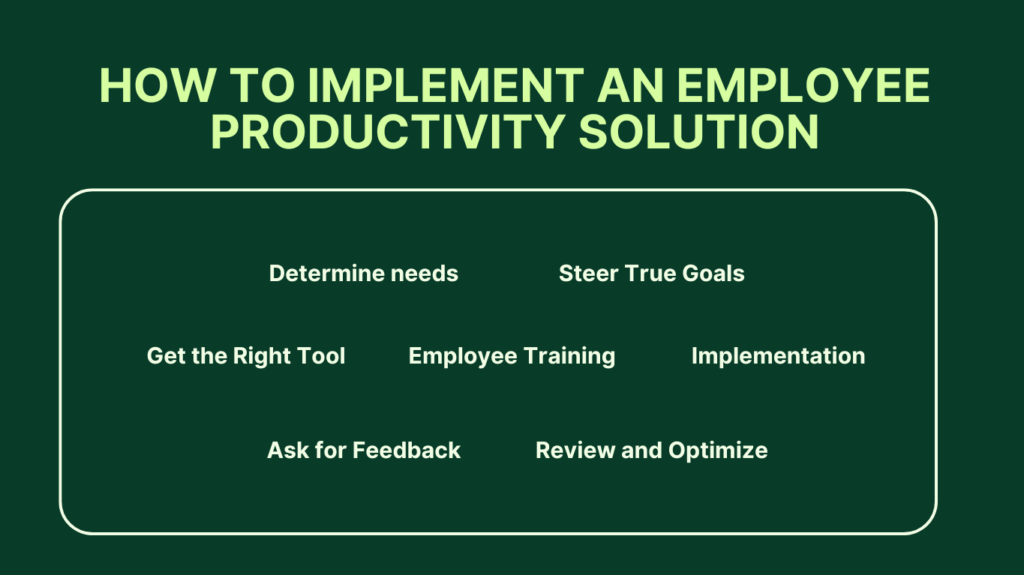
Determine needs: First, define what you are resolving. Identify certain inefficiencies, communication, or visibility issues that are negatively impacting the performance of your team. This step will make sure that the proposal you arrive at deals with actual business problems.
Steer True Goals: State clear objectives by enumerating key performance indicators (KPI) and productivity metrics by which success will be measured. It is a way of ensuring that the implementation stays on track and the results are visible, and this can be either in terms of reducing idle time, the rate of tasks being completed, or any other area where one wishes to put the measure, such as increasing collaboration.
Get the Right Tool: Choose solutions depending on the size of your business, the structure of your team, and its operational needs. Search scalability, integrating ability, user interface, and available assistance to have a solution that will work with the present and future needs, as well as future requirements.
Employee Training: Train employees how to use the tool, what its features are, and why employees should use it. Training and support would be provided by conducting hands-on training in order to facilitate an easier adoption and inspire employees to use the solution efficiently and confidently.
Implementation: Launch in stages and conduct a pilot test of the solution on a few people. It will enable you to see how it works, gather feedback, and change anything that is needed before a company-wide roll-out.
Ask for Feedback: Keep updating the system with the suggestions of the workforce. Promoting the open exchange of views, surveys, and feedback sessions can also be held in order to narrow down the tool and method of its use.
Review and Optimize: Analyze the acquired data regularly in order to evaluate the productivity trends, roadblocks, and optimize workflows. Apply insights to make adjustments, deliver further training, and improve the general performance.
Common Challenges in Using Employee Productivity Solutions
- Employee Resistance: The employees might complain that they are over-monitored or even mistrusted. This feeling has the potential to cause low morale and participation unless dealt with effectively.
- Information Overload: The amount of information that is produced can be massive. The well-needed insights might be mixed up in the noise, even without the required filters and prioritization, making the system useless.
- Privacy: Collection, sharing, or even mishandling of data relating to employees may have devastating ethical and legal consequences. It is also important to enact privacy measures and be open in terms of what is tracked and why it is done.
- The Customization: Customization might not be related across the departments or teams. Rigid systems may lead to friction and a low adoption rate, as well as bring no desired productivity gains.
Overcoming Challenges with the Right Strategy
- Transparency: Tell the reasons why you need to introduce the solution, and explain how it will work and what it will achieve both to the organization and its employees. Practicing transparency creates trust and lowers opposition.
- Engage Employees: Employees should also be part of the process of choosing and putting the idea into practice. Their work can make tool usability better and make them feel appreciated and respected.
- Assure Compliance: Be Conversant with all the laws and ethical codes governing data protection. Give clear instructions on how data would be collected, stored, and used without running a legal risk to win employee confidence.
- Flexibility: Select an employee productivity tool that would be customizable to your business culture, organizational teamwork, and job-specific needs. This makes the implementation more effective and personal.
Benefits of a Cloud-Based Employee Productivity Solution
Cloud-based solutions provide:
Scalability: Checking any user, device, or department as your team gets bigger is easy. The systems based on the cloud scale along with your organization; this also makes changing infrastructure much more expensive.
Remote Access: Check the productivity levels and access dashboards sit wherever you are. This is especially the case with distant or partial groups, as the supervisor can be enlightened and connected no matter their geographical limitations.
Economy: Do not make big initial investments into hardware or licensing. The cloud software is often a subscription-based environment that comprises updates, end-user support, and maintenance and leading to lower IT costs at the location and improved budget planning.
Automatic built-in: Enjoy automatic feature improvements and patches without user action. This guarantees the fact that your solution will be up-to-date and halfway decent in terms of protection against the newest trends in technology.
Tivazo: A Trusted Employee Productivity Solution
Tivazo is a market leader in the provision of employee productivity solutions that are advanced in line to meet the anticipated requirements of modern businesses. Dedicated to innovation, data privacy, and smooth user experience, Tivazo provides organizations with the instruments to achieve the next levels of efficiency and collaboration.
Whether your team is working remotely or you want to streamline in-office productivity, Tivazo has a complete package of features, such as real-time performance insights, goal-setting and tracking, and smart automation, that will make working a smart process and deliver measurable outcomes.
Tivazo has a user-friendly interface, customizable workflows, and ca ompliance-centered design, and therefore promises an easy implementation process and large adoption rates amongst employees. It is scalable and cloud-based, which means that it will expand as your business expands and meet the evolving productivity needs.
Conclusion
The right choice of an employee productivity solution would change your business. Due to the ability to undergo some strategic steps, which include determining inefficiencies, aligning team goals, and making decisions with the use of data, you can achieve unprecedented growth and success.
The improvement of collaboration and effective alignment of goals, on-the-fly analytics, and support of remote workers, a production solution implemented effectively, can become the basis of long-term optimal functioning.
The thing is to select a platform that can satisfy not only the existing requirements but also be scaled according to the future ones. That is where Tivazo enters.
Want to bring a revolution to your workplace? To find out more about the Tivazo employee productivity solution, go to discover the future of workforce efficiency today.
